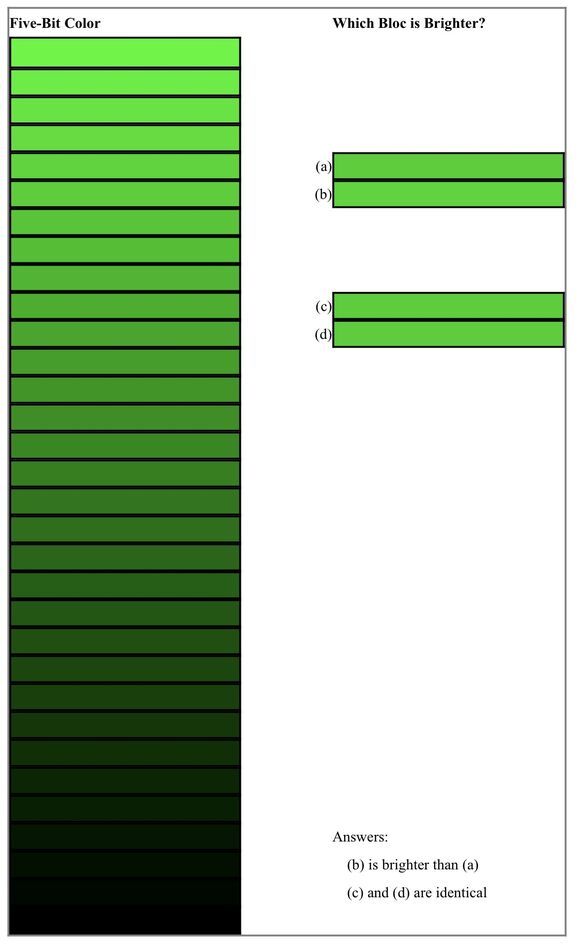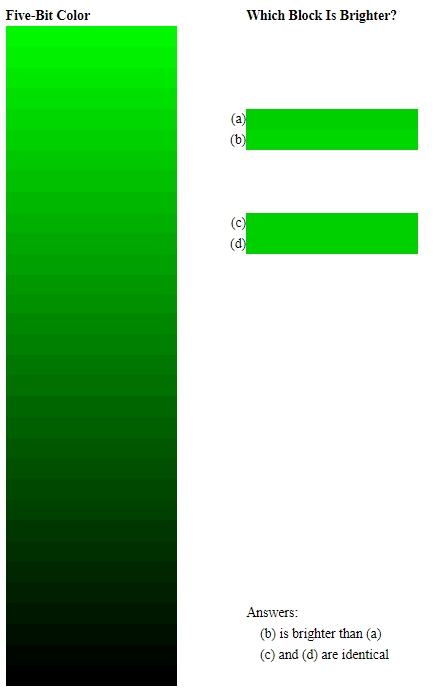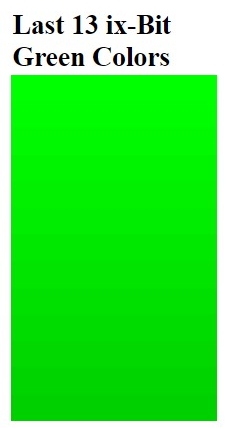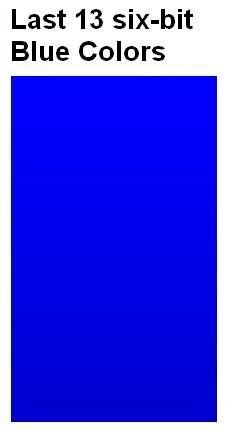Five-bit Color & Human Perception
Aug 2, 2022 12:35:10 #
I am intrigued by the human perception of color and the photographic technology in our cameras' ability to give us smaller steps than we can perceive. So, I put together a small demonstration on a web page using 5-bit color depth for each of the RGB subchannels. Herre is a screenshot of the webpage showing the 32-steps of green and two adjacent pairs for persons to see if they can see which is the brighter one.
I shared the web page with our adult children, and our one daughter gave a typical response. "This was a fun puzzle which I completely failed. I definitely could not tell if one was brighter." If you want to see the webpage on your monitor, here is the web address.
https://richardlbowman.com/colors-5bit.html
Just a few reminders which we might already jump up and say we know. Many researchers have said that humans at our maximum acuity can see one million distinct colors, while others have said ten million. Either value is well below the eight-bit limit of 16,777,216. Also, most computer monitors are eight-bit color devices. Only if one is willing to pay $1000, 5000, etc. USD for a monitor can one buy a 10 or 12-bit device. But I wonder why I would spend such money to have color distinctions I cannot see.
Just some thouoghts. --Richard
I shared the web page with our adult children, and our one daughter gave a typical response. "This was a fun puzzle which I completely failed. I definitely could not tell if one was brighter." If you want to see the webpage on your monitor, here is the web address.
https://richardlbowman.com/colors-5bit.html
Just a few reminders which we might already jump up and say we know. Many researchers have said that humans at our maximum acuity can see one million distinct colors, while others have said ten million. Either value is well below the eight-bit limit of 16,777,216. Also, most computer monitors are eight-bit color devices. Only if one is willing to pay $1000, 5000, etc. USD for a monitor can one buy a 10 or 12-bit device. But I wonder why I would spend such money to have color distinctions I cannot see.
Just some thouoghts. --Richard

Aug 2, 2022 13:40:44 #
I would expect your scale to go from black (which it does) to white (which it doesn't do). 8 bits produces what for most people is a smooth gradation all the way from black to white, but there's very little headroom for allowing pushing and pulling of the brightness levels in editing. You need headroom to keep gradations smooth and to avoid banding.
Aug 2, 2022 15:26:21 #
R.G. wrote:
I would expect your scale to go from black (which it does) to white (which it doesn't do). 8 bits produces what for most people is a smooth gradation all the way from black to white, but there's very little headroom for allowing pushing and pulling of the brightness levels in editing. You need headroom to keep gradations smooth and to avoid banding.
To go from black to white in RGB, one needs to change all three colors. I am only changing the green value while holding red and blue at zero. So, if you look at my HTML code i go from to the lightest green possible with 5-bit color mapped to 8-bit hex color codes. That is from:
background-color:#000000
to
background-color:#00f700
Note that since I am working with 5-bit color mapped to an 8-bit scale, the brightest is not 00ff00. Here are the colors without borderrs on the cells, if that is what you wanted. --Richard

Aug 2, 2022 15:41:01 #
Aug 2, 2022 15:58:40 #
profbowman wrote:
......Here are the colors without borders on the cells,....
To my eye the gradation is anything but smooth. I'm still not sure what point you're trying to make.
Aug 2, 2022 18:11:54 #
R.G. wrote:
To my eye the gradation is anything but smooth. I'm still not sure what point you're trying to make.
Let me try to make my points clearer. First of all, I do not claim that 5-bit color will look smooth when viewing each step in a line. But even with 5-bits, while our eye-brain combination can tell that two colors are different, it cannot distinguish which is the brightest of two colors that are only one-step apart.
Ultimately, my main thesis is that if 5-bit color is this good, then going beyond 8-bit color is useless as far as human viewing of photographs is concerned. To do all of the demonstrations of the color systems from 5-bit through 8-bit would generate a large research paper. I was only trying to give one sample demonstration. Here is a 13 cell pice of the 64-cell long 6-bit color system showing that a six-bit system is almost smooth. --Richard.

Aug 3, 2022 08:09:45 #
profbowman wrote:
I am intrigued by the human perception of color an... (show quote)
Your website was blocked by Malwarebytes, so I looked at the picture on this page. In the first pair, (b) definitely was the brighter of the two. In the second pair, I could not determine that one was brighter than the other, and thought I had failed the test -- but did not!
Some time ago, I took the Farnsworth-Munsell 100 Hue Test (now online with only 40 hue variations, but still interesting), and had a perfect score - apparently highly unusual.
And this was all on my old, cheap Acer monitor.
Loren - in Beautiful Baguio City
Aug 3, 2022 09:49:26 #
profbowman wrote:
Ultimately, my main thesis is that if 5-bit color is this good, then going beyond 8-bit color is useless as far as human viewing of photographs is concerned.


Aug 3, 2022 10:11:40 #
profbowman wrote:
.....going beyond 8-bit color is useless as far as human viewing of photographs is concerned.....
Unnecessary where viewing is concerned, but any further editing will benefit from the extra headroom of a greater bit depth, which is why something better than jpeg is recommended if further editing may be involved. And am I right in thinking that some colour spaces need more than 8 bit data?
Aug 3, 2022 10:14:53 #
profbowman wrote:
To go from black to white in RGB, one needs to cha... (show quote)
With the borders removed it makes a world of difference. Now I can distinguish the subtlety of the tones.
Also, let me say that your 13 cell pice of 6-bit color if it were blue in a sky area would be unacceptable for a photograph because of the banding.
As a third point, 16-bit color is only necessary in large smoothly graduated areas such as a sky otherwise 8-bit is fine. Putting boxes around the tones negates the effect of a large smooth area.
Aug 3, 2022 13:10:41 #
Richard, if your goal is what is adequate for nice display on the web 8 bit JPEGs are fine.
You are also correct that Most people's computer displays are 8bit with a Gamut of something less than sRGB.
You will also find that many Photographs will print fine as JPEGs
But the reason some people choose to have a workflow that maximizes quality and use 10 bit wide gamut displays with 12 bit LUTs etc is because the editing process itself can cause banding and other artifacts as you Boost and cut. You also do not always know which pictures will need the extra headroom to make prints of the highest possible quality. The best wide gamut printers can exceed sRGB easily.
But if you do not have interest in doing those things, you do not need to go to the trouble and expense.
You are also correct that Most people's computer displays are 8bit with a Gamut of something less than sRGB.
You will also find that many Photographs will print fine as JPEGs
But the reason some people choose to have a workflow that maximizes quality and use 10 bit wide gamut displays with 12 bit LUTs etc is because the editing process itself can cause banding and other artifacts as you Boost and cut. You also do not always know which pictures will need the extra headroom to make prints of the highest possible quality. The best wide gamut printers can exceed sRGB easily.
But if you do not have interest in doing those things, you do not need to go to the trouble and expense.
Aug 3, 2022 14:28:57 #
[quote=MJPerini -But if you do not have interest in doing those things, you do not need to go to the trouble and expense.[/quote]
 yes, trouble and expense !
yes, trouble and expense !
 yes, trouble and expense !
yes, trouble and expense !Aug 3, 2022 15:09:42 #
profbowman wrote:
I am intrigued by the human perception of color an... (show quote)
Why bother with 4K TV? No point unless you want a big screen, but the push to mass production makes it cheaper than the previous technology. NEW = sells.
My solution, I watch the old tubes with the old programs. Wonderful sound, stereo on my big box.
I am a little more up to date on computers and cameras, but dropped out of the rat race years ago.
Boris
Aug 3, 2022 16:55:26 #
I agree with fotoartist that the black borders interfere with our evaluation of the brightness of the different colors by interposing a break between them. Without the borders the difference is much easier to see.
Aug 4, 2022 08:27:34 #
Fotoartist wrote:
With the borders removed it makes a world of difference. Now I can distinguish the subtlety of the tones.
Also, let me say that your 13 cell pice of 6-bit color if it were blue in a sky area would be unacceptable for a photograph because of the banding.
As a third point, 16-bit color is only necessary in large smoothly graduated areas such as a sky otherwise 8-bit is fine. Putting boxes around the tones negates the effect of a large smooth area.
Also, let me say that your 13 cell pice of 6-bit color if it were blue in a sky area would be unacceptable for a photograph because of the banding.
As a third point, 16-bit color is only necessary in large smoothly graduated areas such as a sky otherwise 8-bit is fine. Putting boxes around the tones negates the effect of a large smooth area.
Fotoartist, you asked or made three good poiints. Here are my responses.
As physicists, we often try to look at limiting cases. So, I had the initially had borders on cells on a webpage in order to show that under those conditions it is tough to make distinctions between colors that are one-step apart in 5-biit color. But it also shows us that 5-bit color, while almost doing the trick, is not quite what we want. And this also shows us that 8-bit color is definitely more than we need.
As to doing my experiment in blue background colors in a table instead of green, here is the result. Note that banding does not occur. It is always better to do the experiment that just stating an opinion. :)
We do not need 16-bit color as I have shown by my many experiments here. If under only the most controlled and ideal conditions can a human see 10 million colors, i.e., that is 8-bit color in three RGB subchannels, then moving the minimum color step size from 1/256 to 1/(65,536_will not help us see more colors. All that moving from 8-bit to 16-bit gives us then is more colors that look the same. --Richard

If you want to reply, then register here. Registration is free and your account is created instantly, so you can post right away.




